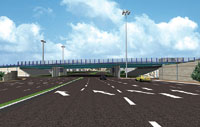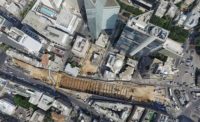 |
| Competition. Growth of rail is forcing movement of road bridge. (Photo courtesy of Shimon Yaron) |
The project also involves removing a nearby high school, building a new bridge for the train and altering traffic flow at the busy intersection. "In the early 80s when the highway was planned, a rail line was not envisioned," says Ira Bar, managing director of Netivei Ayalon Highways Co. Ltd, the state-owned firm that builds and operates the Ayalon Freeway.
The rail line through Tel Aviv runs alongside the freeway. The freeway intersection had to be redesigned to accommodate a new rail link to the citys southern suburbs. "We advised cutting the connection of the bridge to its foundations and rolling it eastward for vehicle use and then building a new bridge designed specifically for heavy rail," says Shimon Yaron, consulting engineer at Yaron, Shimoni, Shacham Consulting Engineers Ltd., Tel Aviv. He says other options would have required costly traffic pattern changes. The move will cost about $15 million.
The existing bridge was designed to accommodate light rail but could not handle heavy rail loads above 50 tons and was too sharply sloped. Rather than tear it down, engineers will separate the bridge deck from piers, lift it with jacks and slide it eastward. A new railway bridge will be built in its place.
Local bidders must joint venture with a foreign partner that has both the expertise and equipment for the work. The move will begin later this summer and be completed by early 2006.
srael must relocate a bridge across the Ayalon Freeway in Tel Aviv, the countrys busiest highway, to make room for a key rail line. In a first of its kind operation in Israel, the bridges eastbound section will be cut away and moved 15 meters sideways. The westbound section will remain in place.

Post a comment to this article
Report Abusive Comment